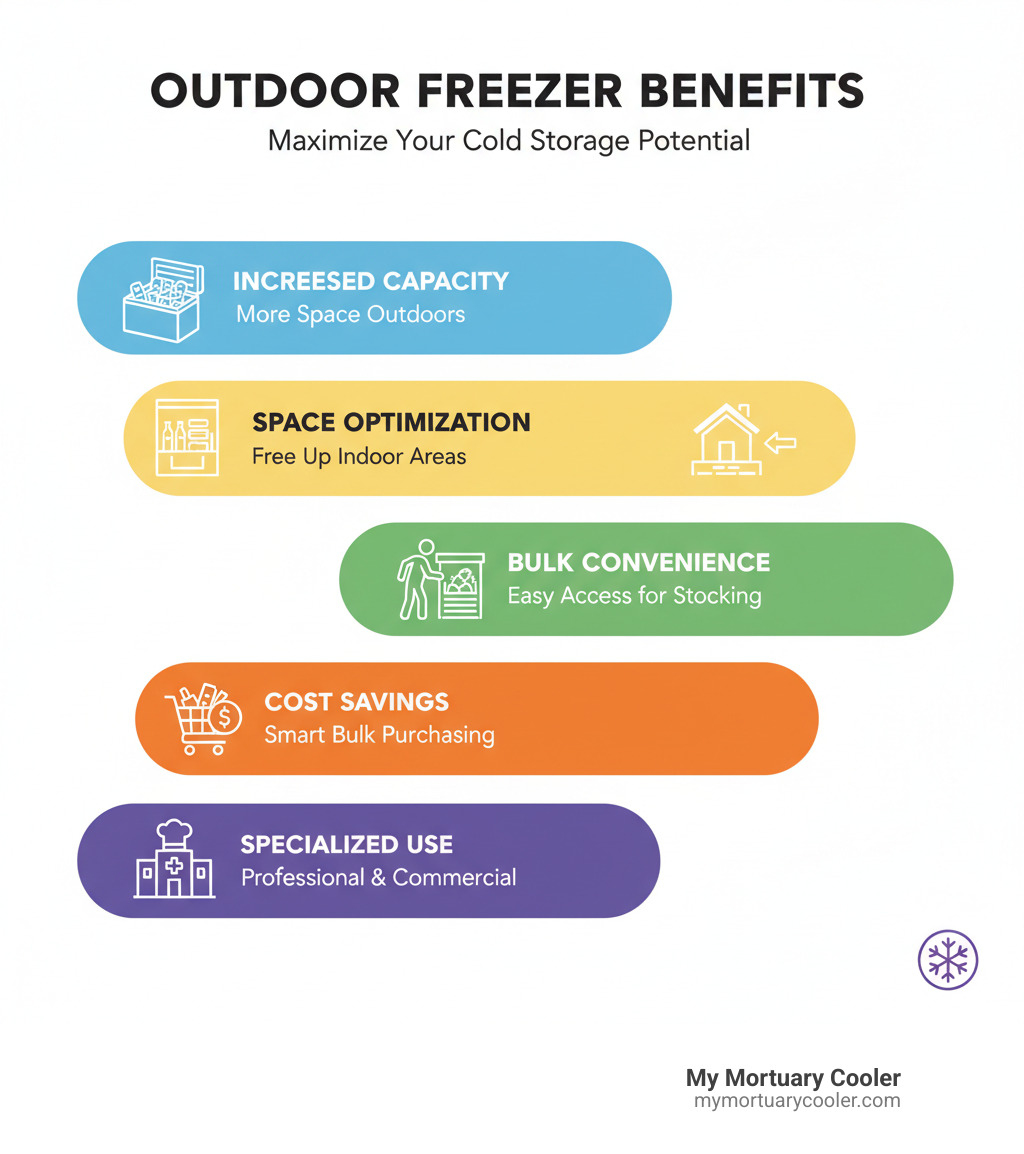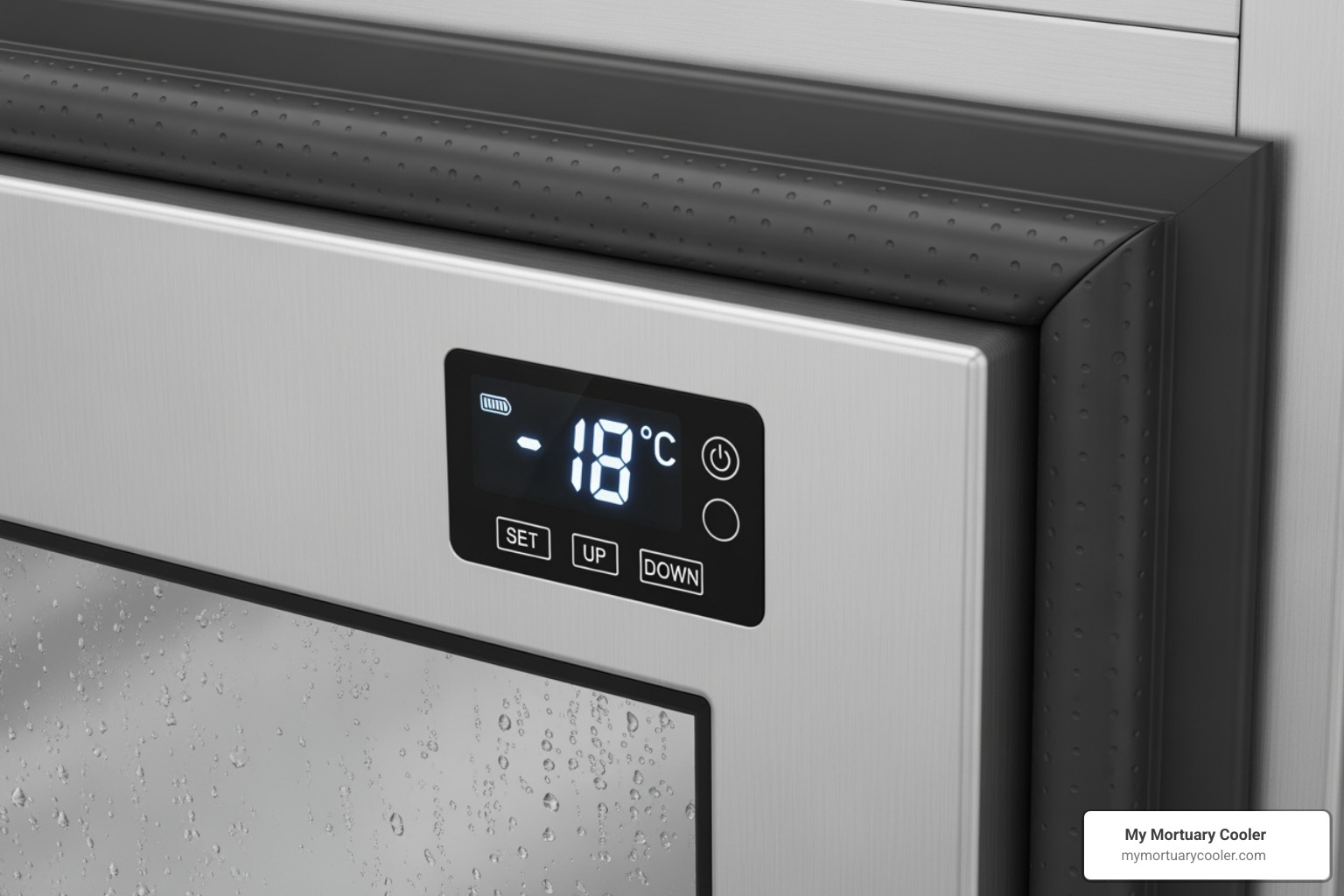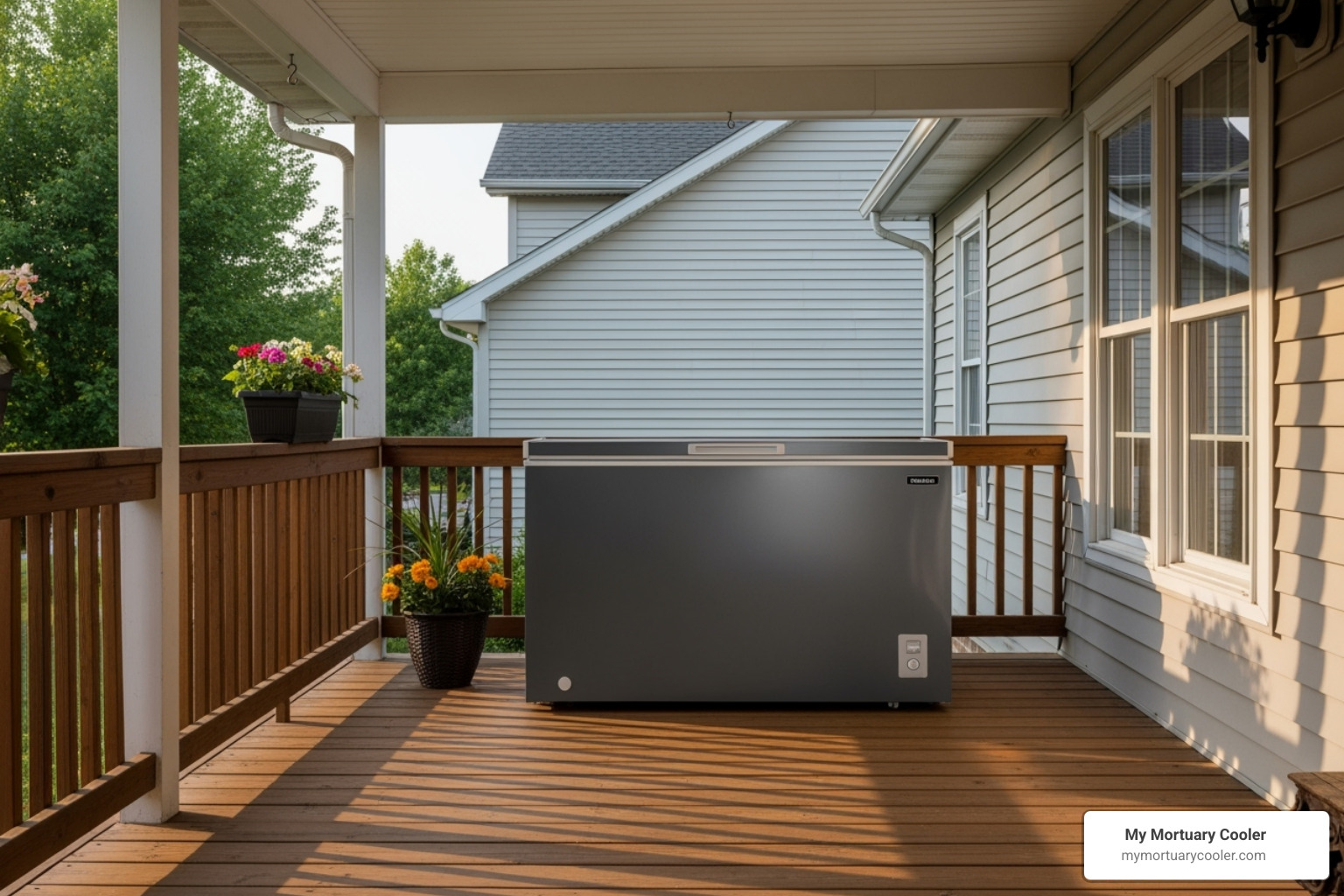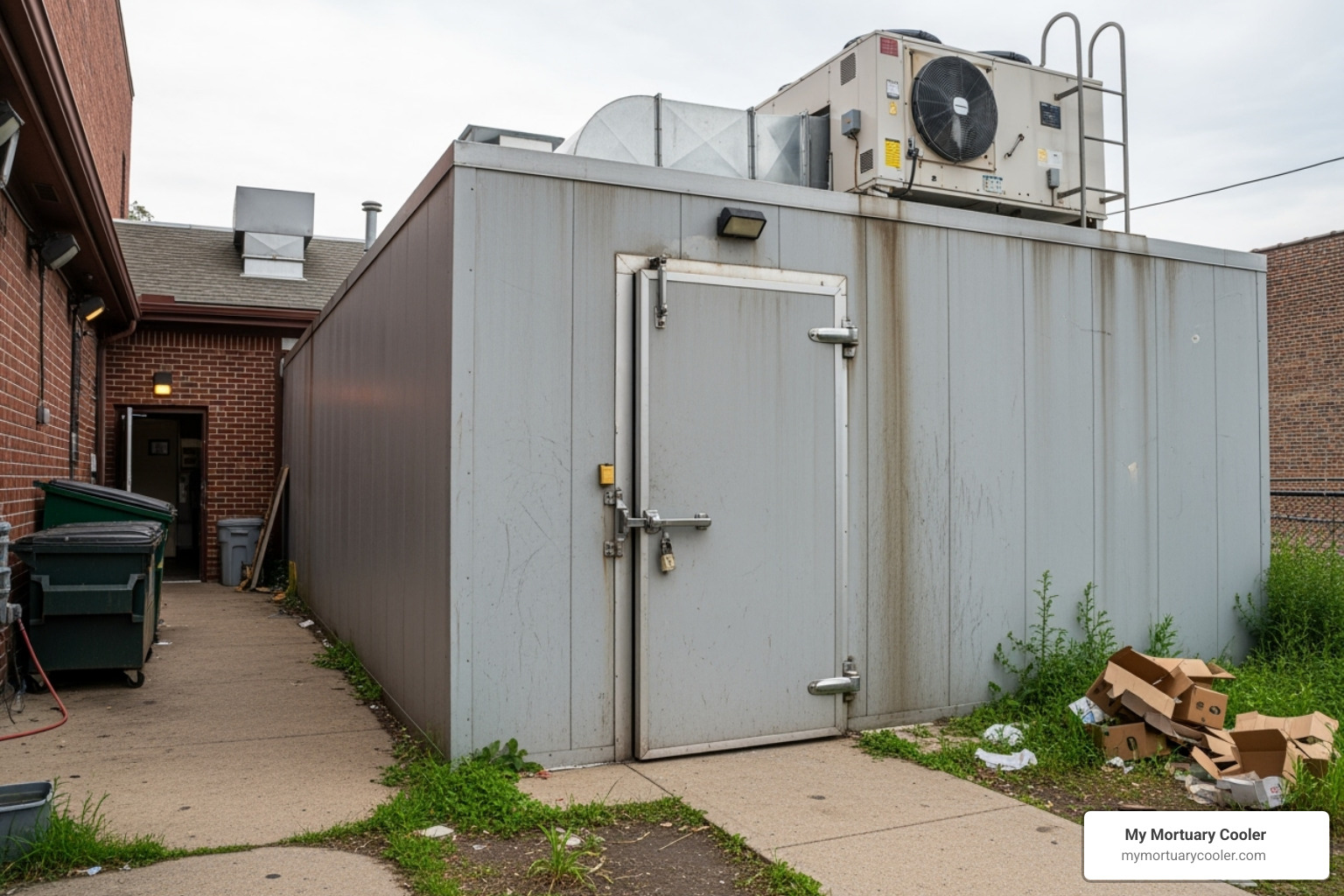Why Take Your Cold Storage Outside?
An outdoor freezer is a weatherproof refrigeration unit designed to operate safely in exterior environments, offering expanded cold storage capacity for homes, businesses, and specialized facilities. These units feature robust construction, improved insulation, and components rated for temperature fluctuations and outdoor conditions.
Top Benefits of Outdoor Freezers:
- Increased Storage Capacity - Add significant freezer space without renovating indoors
- Space Optimization - Free up valuable indoor kitchen or facility space
- Convenience - Easy access for bulk storage, outdoor entertaining, or workflow efficiency
- Cost Savings - Enable bulk purchasing and reduce trips to suppliers
- Specialized Applications - Perfect for mortuary facilities, restaurants, and high-volume operations
The research shows that chest freezers are actually designed to be used outdoors, with white exteriors that reflect heat and raised motors protected from dirt and rain. However, not all freezers are suitable for exterior placement - you need models specifically engineered for outdoor conditions.
"A chest freezer is a great addition to any home and is perfect for large families or anyone who likes to purchase or store food in large quantities," notes appliance experts. For professional facilities like mortuaries, the benefits extend to improved workflow efficiency and compliance with storage requirements.
The key is choosing the right type of outdoor-rated unit and placing it properly. Models labeled "Garage Ready" typically operate in wider temperature ranges (0°F to 110°F), while standard freezers may struggle in extreme conditions.

When you're passionate about gardening, hunting, or simply feeding a large family, you know the struggle of a full freezer all too well. Imagine the freedom of bulk buying discounts, the satisfaction of preserving your harvest, or the convenience of storing game meat without cramming your kitchen freezer. That's the magic an outdoor freezer can bring! It’s not just about extra space; it’s about open uping new possibilities for your home or business. We've seen how specialized cold storage solutions can revolutionize operations, from culinary ventures to professional mortuary services.
Key Features to Look for in an Outdoor Freezer
Shopping for an outdoor freezer is like choosing a trustworthy friend who'll stand by your side through thick and thin – and scorching summers and freezing winters! Unlike their pampered indoor cousins, these units need to be tough enough to handle whatever nature throws their way while keeping your frozen goods perfectly preserved.

The secret to finding the right outdoor freezer lies in understanding what makes these units special. Weather resistance sits at the top of the must-have list – this isn't negotiable. Your freezer needs sealed components, rust-resistant materials, and construction that can laugh off rain, snow, and UV rays. Many commercial-grade units feature fiberglass exteriors that maintain their appearance with minimal maintenance.
Stainless steel construction offers another layer of protection, especially for doors and exterior panels. It's not just about looking professional – stainless steel provides superior resistance to corrosion and rust, making it perfect for outdoor environments.
The heart of any good outdoor freezer is its insulation quality. High-density urethane insulation works overtime to maintain consistent temperatures while keeping your energy bills reasonable. This becomes crucial when your freezer is battling fluctuating outdoor temperatures all day long.
Never compromise on UL-rated outdoor certification. This stamp of approval means the unit has passed rigorous testing for outdoor electrical and environmental conditions. Without it, you're essentially playing freezer roulette with your investment.
Digital temperature controls give you precision that's especially important outdoors. When ambient temperatures swing wildly, having accurate temperature monitoring and adjustment capabilities keeps your frozen items safe. Many units now feature easy-to-read digital displays that work even in bright sunlight.
Security locks protect your investment from both two-legged and four-legged visitors. A sturdy integrated lock system prevents theft and keeps curious animals from helping themselves to your frozen goods. Frost-free operation rounds out the premium features, eliminating the chore of manual defrosting and preventing ice buildup that can reduce efficiency.
For those considering larger-scale solutions, our The Complete Guide to Choosing a Walk-In Freezer dives deeper into high-capacity cold storage options.
What types of outdoor freezer are available?
The outdoor freezer market offers something for everyone, from weekend warriors to commercial operations. Each type brings its own personality and strengths to the table.
Chest freezers remain the energy efficiency champions thanks to their top-opening design that keeps cold air from spilling out every time you open them. Many standard chest freezers perform admirably outdoors when properly protected, though dedicated outdoor models offer improved weather resistance.
Upright freezers appeal to the organizationally minded, offering shelves and drawers that make finding that bag of frozen peas a breeze. While they use slightly more energy than chest models, many "garage-ready" upright freezers handle outdoor conditions beautifully.
Speaking of "garage-ready" models, this designation is your golden ticket for outdoor placement. These units operate efficiently in temperature ranges from 0°F to 110°F, addressing the challenges that would shut down or overwork standard freezers. They're engineered specifically for unconditioned spaces where temperatures fluctuate dramatically.
Portable 12V freezers serve the adventure crowd perfectly. These compact units run on DC power from vehicles or RVs, offering true mobility for your frozen needs. They're perfect for extended camping trips or marine applications where traditional freezers can't follow.
Commercial walk-in units represent the ultimate in outdoor cold storage. These modular powerhouses offer massive capacity with industrial-grade construction designed for outdoor installation. They can be configured as standalone outdoor units or "thru-wall" installations for convenient indoor access. You can explore more about different freezer options to understand which solution fits your needs.
How does an outdoor freezer compare to an indoor freezer?
While both indoor and outdoor freezers share the same basic mission, their execution differs dramatically when Mother Nature enters the equation.
| Feature | Indoor Freezer | Outdoor Freezer |
|---|---|---|
| Durability | Designed for stable indoor climates | Robust construction, weather-resistant materials (stainless steel, fiberglass) |
| Weatherproofing | Minimal to none | High-grade seals, UV-resistant finishes, protected components |
| Initial Cost | Generally lower | Often higher due to specialized materials and engineering |
| Energy Efficiency | Optimized for consistent indoor temperatures | Variable; higher consumption in extreme outdoor temperatures |
| Insulation | Standard residential insulation | Improved, high-density insulation for temperature fluctuations |
| Temperature Range | Typically operates in 60-80°F ambient | Designed for wider ranges (0-110°F for "garage ready") |
| Installation | Simple plug-and-play | Requires careful placement, electrical safety, weather protection |
| Lifespan | Longer if maintained in ideal conditions | Potentially shorter without proper protection and maintenance |
The construction difference is like comparing a house cat to a mountain lion – both are cats, but one is built for comfort while the other thrives in harsh conditions. Outdoor freezers feature commercial-grade insulation, weather-sealed doors, and components designed to handle temperature swings that would overwhelm indoor units.
The initial investment runs higher for outdoor models, but this premium pays dividends in reliability and performance. These units incorporate specialized materials and engineering that justify the extra cost when you consider the alternative of replacing failed indoor units exposed to outdoor conditions.
Energy consumption becomes more complex outdoors. While these units work harder during temperature extremes, their improved insulation helps offset the extra demand. An Energy Star-rated outdoor freezer represents your best bet for balancing performance with efficiency, especially during those scorching summer days or bitter winter nights.
Placement, Installation, and Safety
So, you've chosen your robust, weather-resistant outdoor freezer – excellent! But where do you put it, and how do you ensure it's safe and compliant? Just like real estate, location, location, location is key to your outdoor freezer's longevity and performance.

What are the best locations to place an outdoor freezer?
Finding the perfect spot for your outdoor freezer means balancing protection from the elements, easy access, and good airflow. Let's explore some great options.
A covered porch or patio is often a fantastic choice. This kind of area acts like a shield, protecting your freezer from direct rain, snow, and harsh sunlight. This protection can really cut down on how hard your unit has to work and make it last longer. Just think about how far you want to walk to grab those frozen treats!
Your garage is another popular spot, especially if you have a "Garage Ready" model. It keeps the freezer safe from direct weather and adds an extra layer of insulation. That garage temperatures can swing quite a bit, so that "Garage Ready" label is truly important. Also, if you do woodworking or other dusty hobbies, watch out for dust that might affect the compressor.
A sturdy shed can also offer excellent protection. Just make sure it's well-ventilated. You don't want your freezer crammed into a tight corner where it can't "breathe." Many people have successfully kept freezers in sheds for years, even in tough weather.
Some folks find success placing their freezer under a stilt house or a deep overhang. This can give enough shelter from most weather. The main thing here is to be sure it's truly protected from rain that blows sideways or snow carried by the wind.
No matter where you place it, always put your outdoor freezer on a stable and level surface. This helps the compressor work correctly and prevents any unnecessary strain on the unit.
Finally, air circulation space is super important! Your freezer needs room all around it to breathe. Make sure there's enough space – usually several inches – around the back and sides. If you block the vents or push it too close to a wall, the compressor will work harder. This means more energy use and more wear and tear.
Try to avoid spots prone to flooding, too much dust, or corrosive elements like salty air if you live near the coast. Salty air can cause a lot of rust, making some coastal outdoor spots unsuitable for many units. For more helpful tips on outdoor placement, you can check out Can I Leave a Chest Freezer Outside?.
What are the safety and legal considerations?
When you're putting an electrical appliance outdoors, safety is the number one concern. Sometimes, local rules can also come into play.
For electrical safety, always plug your outdoor freezer into a GFCI (Ground Fault Circuit Interrupter) outlet. These special outlets are designed to prevent electric shocks by cutting power if they sense a problem. If you don't have one, it's a good idea to have a qualified electrician install it.
If you absolutely need an extension cord (though plugging directly into an outlet is always best), it must be a heavy-duty, outdoor-rated cord. Never use an indoor extension cord, and please don't connect several cords together. That's a big no-no for safety!
Child entrapment prevention is a very serious issue, especially with chest freezers. Make sure your unit is lockable and keep it locked when it's not being used. If you ever get rid of an old freezer, always remove the door or lid. This simple step can prevent tragic accidents and keep children safe.
It's also smart to check with your local municipality or Homeowner Association (HOA) rules before placing a large appliance outside. Some areas have rules about what appliances you can see from the street, how much noise they make, or even how they look. We don't want any unexpected visits from the local authorities!
Finally, any permanent outdoor wiring or installation must follow electrical code compliance for your area. If you're unsure about anything, always bring in a licensed electrician.
Taking these steps ensures your outdoor freezer runs safely and keeps your property and loved ones protected.
Performance, Efficiency, and Maintenance
Your outdoor freezer is built to be tough, but it's fighting a constant battle against Mother Nature. Understanding how weather affects performance – and knowing how to care for your unit – can mean the difference between years of reliable service and an expensive repair bill.
Think of it this way: your freezer is like a marathon runner. In perfect conditions, it cruises along efficiently. But when the temperature soars or plummets, it has to work much harder to maintain that consistent internal chill.
How does outdoor temperature affect freezer performance?
Weather is your outdoor freezer's biggest challenge, and it affects performance in ways that might surprise you.
Summer heat is the obvious enemy. When temperatures climb above 90°F, your freezer's compressor becomes a workhorse, running longer and more frequently to fight the heat. Direct sunlight makes this even worse – it's like asking someone to run a marathon while wearing a winter coat. This translates directly to higher energy bills and more wear on your unit.
But extreme cold can be just as problematic. Here's where it gets interesting: if it's already freezing outside, your freezer's compressor might think, "Hey, I don't need to work as hard!" Unfortunately, this can lead to temperature fluctuations inside the unit. Standard freezers can struggle when ambient temperatures drop below their design range, sometimes shutting down completely or failing to maintain proper internal temperatures.
This is exactly why "Garage Ready" models are worth their weight in gold. These units are engineered to handle a much wider temperature range – typically from 0°F to 110°F – without missing a beat. They're like the all-weather athletes of the freezer world.
Shade becomes your secret weapon in this temperature battle. A simple awning or strategic placement under an overhang can dramatically reduce your freezer's workload and extend its life. We've seen units placed in direct sun fail years earlier than their shaded counterparts.
For more insights on temperature management and avoiding common mistakes, check out our guide on Beginner Freezer Temperature Mistakes and How to Avoid Them.
How do I maintain my outdoor freezer?
A little TLC goes a long way with outdoor freezers. The good news? Most maintenance tasks are simple and don't require calling a technician.
Start with the condenser coils – they're usually on the back or bottom of your unit. These coils are like your freezer's lungs, and they need to breathe freely to work efficiently. Dust, leaves, and outdoor debris love to collect here, creating an insulating blanket that forces your compressor to work overtime. A good cleaning twice a year (we suggest January and July) with a vacuum or brush can save you serious money on energy bills.
Don't forget those door gaskets. These rubber seals are your first defense against warm air sneaking in. Give them a monthly once-over, looking for cracks or wear. Clean them with mild soap and water to remove any grime. Here's a simple test: close the door on a dollar bill – if it slides out easily, your seal needs attention.
Keep drainage clear if your unit has a drain. Blocked drains can lead to water pooling, and nobody wants that mess. This is especially important after manual defrosting or during humid weather.
The exterior needs love too. Even weather-resistant materials benefit from regular cleaning. Wipe down surfaces to remove dirt, pollen, and salt residue (especially if you live near the coast). For stainless steel units, this prevents water spots and maintains that professional look. Some folks even apply automotive wax to painted surfaces for extra protection – it's like sunscreen for your freezer!
Manual defrosting shouldn't be ignored if your unit requires it. Once ice buildup reaches a quarter-inch thick, it's time to defrost. That ice acts like insulation, making your compressor work harder and stealing valuable storage space.
Finally, keep the area around your freezer tidy. Clear away leaves, debris, or anything that might block airflow. Your freezer needs room to breathe, just like you do after a good workout.
These simple maintenance steps aren't just busy work – they're your insurance policy against expensive repairs and premature replacement. A well-maintained outdoor freezer can serve you faithfully for many years, even in challenging outdoor conditions.
Commercial-Grade Outdoor Freezers
When your business or facility needs serious cold storage power, residential outdoor freezer units just won't cut it. We're talking about commercial-grade solutions built like fortresses – units that laugh at harsh weather and keep running 24/7 without missing a beat.

At My Mortuary Cooler, we understand that when you're dealing with mortuary refrigeration, restaurant storage, or any critical cold storage application, "good enough" simply isn't an option. Your outdoor freezer needs to be bulletproof reliable, because downtime isn't just inconvenient – it can be catastrophic.
Commercial walk-in freezers represent the pinnacle of outdoor cold storage engineering. These aren't appliances you plug in and hope for the best. They're precision-engineered systems designed to handle whatever Mother Nature throws their way while maintaining exact temperatures day after day, year after year.
The magic starts with one-piece seamless construction. Instead of assembling panels and hoping the seals hold up, the best commercial units are built as monolithic structures. This means no weak points, no seams to fail, and no panels coming loose during the next big storm. It's like the difference between a house of cards and a solid concrete bunker.
Fiberglass exteriors are game-changers in the outdoor freezer world. While metal units rust and dent, fiberglass units keep looking factory-fresh for decades. They won't corrode in salty coastal air, won't dent when hail hits, and won't fade under relentless UV exposure. Plus, they're surprisingly easy to clean – a simple hose-down keeps them looking professional.
The insulation in commercial units is in a different league entirely. High-density urethane insulation doesn't just keep things cold – it creates an almost impenetrable thermal barrier. This translates directly to your bottom line through dramatically lower energy costs. When you're running a large freezer 24/7, those savings add up fast.
What really sets commercial units apart is their factory-tested refrigeration systems. These arrive ready to plug in and fire up immediately. No waiting for technicians, no on-site assembly headaches, no wondering if everything was installed correctly. The manufacturer has already done the hard work and tested everything before it leaves the factory.
The durability factor is where commercial units truly shine. We're talking about 12-year complete structural warranties on some models – that's confidence in construction you just don't see with residential units. These freezers are built to handle decades of continuous operation in challenging outdoor environments.
For mortuary facilities, restaurants, research labs, or any operation where cold storage failure isn't an option, commercial-grade outdoor freezers provide the reliability and precision you need. We've seen too many businesses learn this lesson the hard way after trying to make do with residential units.
Ready to explore commercial solutions that won't let you down? Check out our comprehensive guide: Take It Outside With These Top Outdoor Walk-In Coolers. And if energy efficiency is a priority (and when isn't it?), find how modern commercial units deliver impressive performance at Energy efficient walk-in freezers.
Conclusion: Find Your Perfect Exterior Freezing Solution
The journey to finding the perfect outdoor freezer doesn't have to be overwhelming. Throughout this guide, we've explored how these remarkable appliances can transform your storage capabilities, whether you're a busy family looking to take advantage of bulk buying opportunities, a passionate hunter needing space for your harvest, or a professional facility requiring reliable cold storage solutions.
The magic happens when you match the right freezer to your specific needs and environment. Increased storage capacity opens up possibilities you might never have considered - from preserving garden bounties to streamlining commercial operations. Freeing up indoor space gives your kitchen or facility room to breathe, while the convenience for outdoor entertaining means your next barbecue or gathering runs seamlessly.
But here's what we've learned matters most: always choose a UL-rated model designed for outdoor use. This isn't just a suggestion - it's your insurance policy against costly failures and safety hazards. Those robust features we discussed - weather-resistant construction, quality insulation, and digital temperature controls - aren't luxury add-ons. They're the foundation of a freezer that will serve you reliably through seasons of scorching heat and bitter cold.
Proper placement is your secret weapon for longevity. That covered porch, well-ventilated garage, or sturdy shed isn't just protecting your investment from the elements - it's ensuring optimal performance and energy efficiency. A little shade and adequate airflow can make the difference between a freezer that struggles and one that thrives.
The beauty of modern outdoor freezers lies in their versatility. From compact chest models perfect for weekend warriors to commercial-grade walk-in units that handle serious business demands, there's a solution for every situation. For facilities requiring the ultimate in reliability and performance - particularly in specialized applications like mortuary services - commercial-grade units with seamless construction and superior insulation represent an investment in operational peace of mind.
Your perfect exterior freezing solution is out there, waiting to revolutionize how you think about cold storage. Choose wisely, install thoughtfully, and maintain regularly - your future self will thank you every time you open that door to perfectly preserved contents.
For professional-grade mortuary refrigeration and equipment, explore our ultimate guide to walk-in mortuary coolers and products.